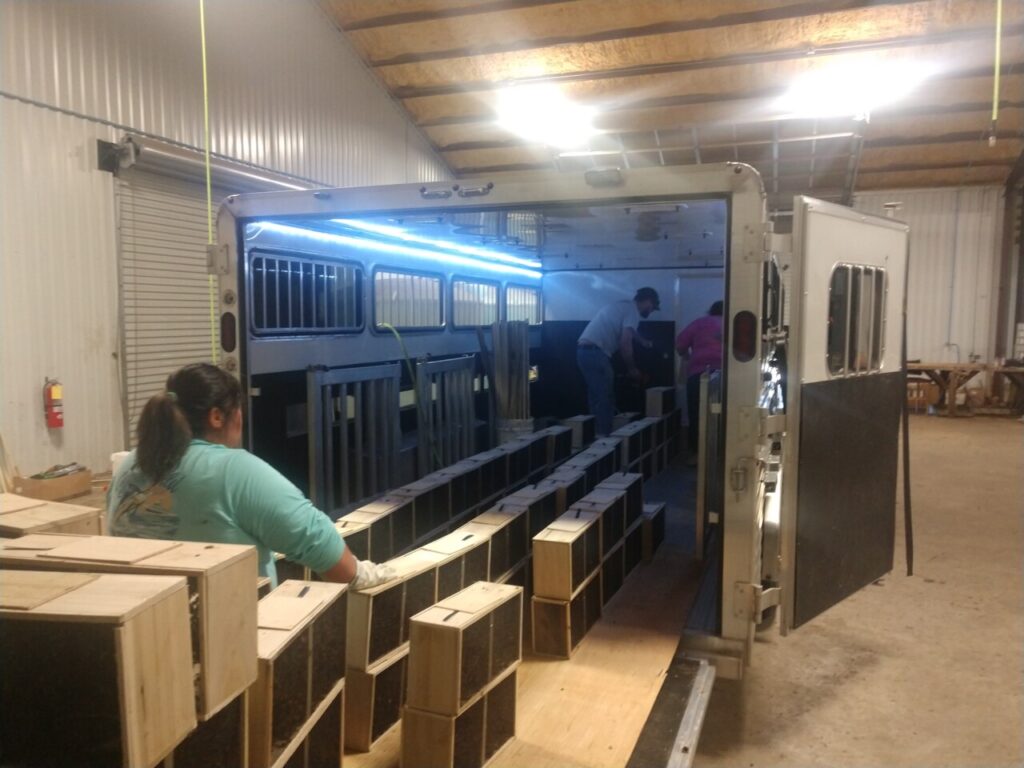by Tim Caldwell
Editor’s Note: As someone who started beekeeping in earnest last year, there was a lot I didn’t know about, well, everything. In fact, I may know less now that I did when I first started, and I’m mostly at peace with that. But one area that gave me confidence working with and responding to my new bees was learning about where my bees come from and how they are produced and raised – they are essentially livestock, right? In part one of this series, Tim Caldwell shares background information and tips to help us know what to expect and what questions to ask of our bee supplier. – Jeremy

Why are package bees a southern thing?
The package bee industry was started around the turn of the 20th century to supply beekeepers in northern climates a source to replace lost colonies early in the year. Originally, bees on combs or in nucs were shipped by train, but when American foul brood was running rampant, packages were developed so that no comb was shipped to spread the disease. The package industry naturally developed in the warmer climates of the US because package suppliers can start producing queens as early as mid February in the far south coastal areas. These areas generally have an earlier access to pollen than the Midwest.
In central Indiana, the first pollen doesn’t come into the hives until late February when the maples bloom. It will be at least 40 days after that until you have mature drones, and they are needed to mate with the newly produced queens. For Indiana, that means queens can’t be bred reliably until around the first to mid-April, dependent on weather. Simply put, Indiana-produced packages would not have the time for the colony numbers or honey production some beekeepers need and/or expect. Package bees from southern climates can give that head start.
How are package bees made, and why should I care?
Most package suppliers take great pride in their bees and the quality of their packages. Many of the large suppliers have been in business for decades. Package bees have gotten a bad rap because most beekeepers are not educated on two main aspects:
- The process of making the packages
- The process of properly installing the bees in their new home
Drawing from the research I have read, approximately 30-35% of packages report queen problems. (There’s not reliable data on queen problems with nucs or natural splits – there too many variables!) Not all the problems can be attributed to “bad” queens, though. Some of the problems are about the package process. Many of the problems can be linked to the bees not having access to brood pheromone while they are in the package. Also, all the queens in packages are young, newly mated queens that have not had time to develop strong queen pheromones. If a package supplier runs into bad mating weather, the queen could be a banked queen who has not been laying for a week or more. When a queen is banked, she stops laying and stops producing pheromone. When a package is installed on new foundation, because of lack of brood and queen pheromone, the bees assume the queen is no good and start the supersedure process as soon as the queen starts laying a few eggs. There have been experiments with adding synthetic brood and queen pheromone to the packages when they are being produced but it did not help significantly. Some package suppliers run a 14-day mating cycle on their mating nucs. This means a ripe queen cell is installed in the mating nuc and the queen is harvested in 14 days and a new cell is placed in the nuc. Most of the time this only allows the new queen to have been laying for 2-5 days. Better suppliers run a 20–21-day mating cycle. This allows the queen to mature 1 extra week. This has been shown to increase queen acceptance by at least 25%. This one thing can help reduce package problems to around 10%.
If a supplier is going to produce large quantity of packages early in the year, they have to start the previous summer – pulling honey, treating for mites, and getting the hives ready for winter. Through the winter, they are checking and feeding as necessary. After the winter solstice, it’s time to start feeding protein to stimulate brood rearing. As all of this is happening, they have to get the package cages ready/assembled, feeding cans prepared, and queen cages assembled and stocked with candy. When the hives have mature drones, the queen production can begin. Then (as early as mid-March) the assembly and shipping can begin. Mated queens are harvested and caged, bees are shaken, packages are weighed, queens and feeder cans installed. This goes on 7 days a week until late May, approximately 10 weeks. Think of the logistics of grafting enough queens to have 800-1000 mated and caged queens per day for 60-70 days while maintaining enough support colonies to supply ample drones for mating and enough colonies to supply the 2400-3000 pounds of bees per day for the packages. Large suppliers will produce 50,000 to 70,000 packages per year.
The bottom line here is to ask your supplier questions about their process. Not only will you learn more about your bees, you’ll be better prepared to deal with any problems.
